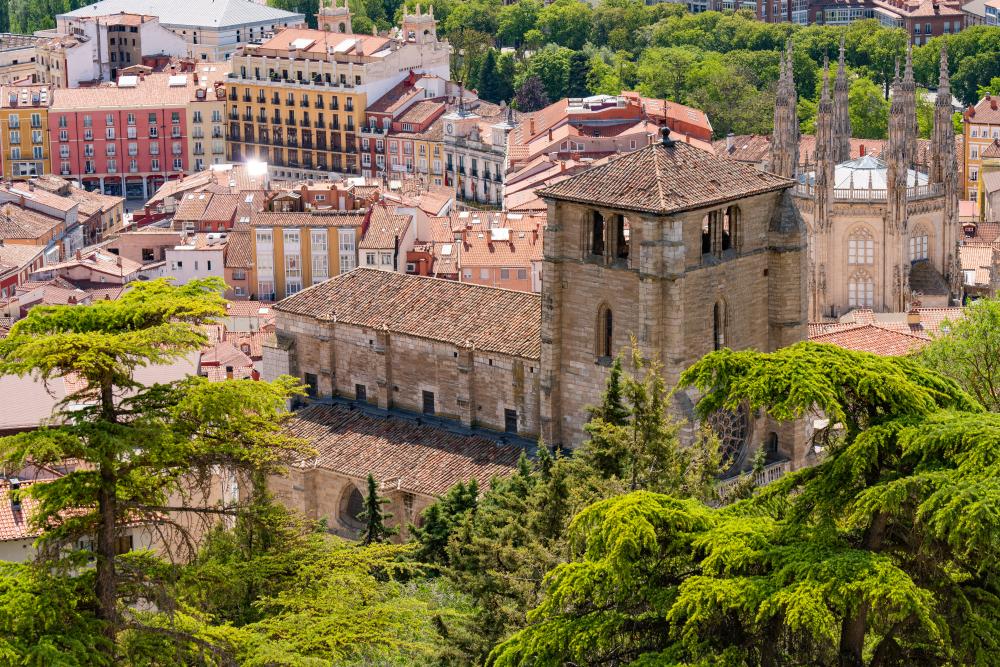1-CASTLE OF BURGOS
The castle was founded in 884 by Count Diego Porcelos. This was the origin of the city of Burgos, which grew contemplating some of the most transcendent moments of its history. Unfortunately, during the Spanish War of Independence, the French army destroyed the castle ny blowing up the arsenal inside it. You can now visit the ruins left from that time. Interestingly, the well inside the castle is one of the deepest in Europe, at almost 63 meters deep. An old legend is told about a treasure hidden by the French army in the underground tunnels.
2-GATE OF SAN ESTEBAN
It was one of the twelve gates to access the city in the middle 13th century, although its current condition corresponds to a Mudejar construction built by experts with an Islamic origin in 1372. The main parts are the sides of the gate and the Moorish arch.
3-CAB. CENTRO DE ARTE CAJA DE BURGOS
In the area known as the Gothic district you can find the Art Centre of Burgos, also known as CAB. In this innovative space, which has had the ability to connect contemporary architecture with the historical buildings surrounding it, you can visit an excellent example of cutting-edge trends in the art world. If that’s not enough reason to visit, its sophisticated exterior terrace has some unique views of the cathedral.
4-CHURCH OF SAN ESTEBAN AND ALTARPIECE MUSEUM
The Church of San Esteban is a magnificent representation of gothic style, although the interior of the temple combines different styles. It was built between the 12th and 14th centuries, replacing the old Romanesque-style church. We can admire the rose window of its façade and inside the temple the most remarkable parts are the pulpit, choir and the cloister. Nowadays it hosts the altarpiece museum with pieces of great artistic value, many of them were brought from other churches to restore or protect them.
5-GATE OF FERNÁN GONZÁLEZ
The gate of Fernán González, built by the master Juan Ortega de Castañeda between 1584 and 1587 in remembrance of Count Fernán González. This monument was built in the place where the house of Fernán González was once situated, in the old Tenebregosa street. Nowadays it is called Calle Fernán González street. It is a huge classicist-style triumphal arch of a semi-circular shape and flanked by Tuscan pillars and coats of arms with an inscription of Fray Luis de León: Year 1592 ‘’To Fernán González, Count of Castile, in his glorious time, father of kings. In the place of his home this monument rises in everlasting memory of his name and the city’’. (“A Fernán González, Conde de Castilla, en su tiempo gloriosísimo caudillo, padre de grandes reyes. A tal paisano, en el solar de su casa, con dinero común, se alza este monumento, para la memoria sempiterna de su nombre y la ciudad”).
6-MONUMENTO AL EMPECINADO
This monument was built in 1844 to house the remains of Juan Martín Díaz ‘’El Empecinado’’. He was a famous warrior in the fight against the Napoleonic army and a defender of the Constitution of Cadiz. The place where it’s located, near to the gate of Fernán González and Solar del Cid, transformed the old hill where the city started to grow into a place of tribute to heroes of the past.
7-SOLAR DEL CID
It is believed that this is the place where the residence of El Cid once stood, which, because of its poor condition, had to be demolished. In 1784 three memorial steles were built with the coat of arms of Burgos and San Pedro de Cardeña.
8-GATE OF SAN MARTÍN
It was one of the twelve gates to access the city, and like the gate of San Esteban, it was made by Arabic masters in 1372 with a Moorish arch and the mixture of stones and bricks. For many centuries it was the gate where the kings accessed the city after taking their oaths, but it was later replaced in this function by the gate of Santa María. Through the gate of San Martín, the pilgrims that were on their way to Santiago left on their way to the Hospital del Rey.



